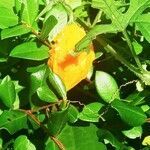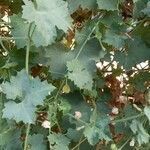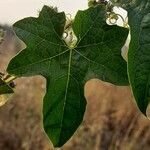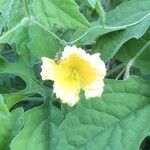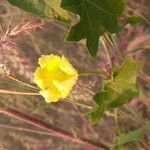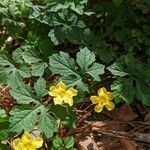Climber or trailer to 1.5 m.. Stems herbaceous, glabrous or pubescent.. Leaf-blade broadly ovate, reniform or orbicular in outline, cordate, usually somewhat pubescent, 10–90 mm. long, 12–120 mm. broad, palmately 3–5-lobed to about the middle or below, with the lobes broadly ovate-or elliptic-rhombic in outline, narrowed below, sharply sinuate-dentate or dentate-lobulate and the apices and marginal teeth apiculate; petiole pubescent, 4–60 mm. long.. Tendrils simple.. Monoecious.. Male flowers solitary; peduncle 17–35 mm. long, bearing an apical 4–18 mm. long 9–34 mm. broad broadly ovate-cordate apiculate veined bract; pedicels 4–5 mm. long, ± pubescent; receptacle-tube obconic, 2 mm. long; lobes ovate-acuminate, acute, green, 5–7 mm. long; petals yellow with green veins, 10–15 mm. long, 8–12 mm, broad; stamens 3.. Female flowers with peduncle up to 1.5 mm. long bearing a small apical ovate bract (up to 2 × 2 mm.); pedicel 4–5 mm. long, pubescent; ovary fusiform and beaked, 6.5–7 mm. long, ± 3 mm. across, puberulous, with longitudinal rows of small tubercles; receptacle-tube shallow; lobes narrow, 2.5–5 mm. long; petals rounded-apiculate, ± 8 mm. long and 5 mm. broad.. Fruit on a 10–20 mm. long stalk, orange-red, ovoid-ellipsoid, ± 26–35 mm. long and 19–25 mm. across, terete or slightly ridged, ornamented with longitudinal rows of small tubercles.. Seeds ovate-oblong in outline, 9–11 × 5–6 × 2.5–3 mm.; testa sculptured; margins 2-grooved.
Monoecious, perennial herb. Stems slender, prostrate or climbing, up to 5 m long. Leaves foetid, up to 90 x 120 mm, outline broadly ovate to suborbicular, deeply cordate, deeply palmately 5-7-lobed; lobes sinuate-dentate or 3-5-lobulate; petioles up to 60 mm long. Tendrils simple. Flowers solitary. Male flowers: peduncle up to 105 mm long; bract ± suborbicular, up to 18 mm long, sessile, pallid with dark green veins and tip; pedicel 2-5 mm long; receptacle tube 2.0-4.5 mm long; lobes 4-9 mm long, ± ovate, blackish or green; petals obovate-oblong, 10-20 mm long, pale yellow to white, green-veined, dark at base. Female flowers: peduncle 2-5 mm long; bract 1.5-5.0 mm long, green; pedicel up to 27 mm long; receptacle tube 0.5-1.0 mm long; lobes narrow, 1-5 mm long; petals up to 13 mm long. Flowering time Dec.-July. Fruit ovoid, rostrate, up to 62 x 28 mm, tuberculate, orange or red, dehiscent into 3 valves; stalk up to 20 mm long. Seeds ovate, flattened, 8.5-11.0 mm long, edges elevated, sculptured, margins grooved, in red pulp.
Monoecious annual or perennial herb, glabrous. Leaves suborbicular, cordate at base; lamina 4–7 cm diam., deeply 5–7-lobed; lobes sinuate-dentate to lobulate, acute; petiole 1–5 cm long. Male flowers: flower-scape 2–8 cm long, bracteate towards top; bract ovate, 12–15 mm long, dentate, acute, pale green with darker veins; hypanthium 2 mm long; calyx-lobes ovate, 3 mm long, acuminate; petals ovate, 12–15 mm long, pale yellow. Female flowers: flower-scape 1–4 cm long, bracteate towards base or bract absent; calyx-lobes subulate, 3–4 mm long; ovary ovoid, 7–8 mm long, attenuate, muricate. Fruit ellipsoidal to fusiform, 3–6 cm long, 2–3 cm diam., slightly ridged and sparsely tuberculate, orange-red; pulp red. Seeds 3–6, ovate, 10–12 mm long, compressed, dark grey, the margin thickened, grooved, crenulate.
Stems pubescent to glabrescent. Leaves: petiole 1–4(–6) cm; blade broadly ovate or reniform to orbiculate, palmately 3–5-lobed, 1–9(–12) cm, base cordate, lobes broadly ovate or rhombic-ovate, sinuses 80–90% to base, margins sinuate-dentate, leaf lobes and teeth apiculate, surfaces glabrous or sparsely hairy. Inflorescences: staminate peduncles bracteate near apex, bracts sessile, broadly ovate-cordate to reniform, margins dentate to denticulate; pistillate peduncles ebracteate or bracteate at base to submedially. Petals yellow, obovate, 8–15 mm. Fruits orange-red, broadly ovoid, 2.5–4(–7) cm, beak becoming less prominent at maturity, surface minutely tuberculate, muriculate in longitudinal rows. Seeds ovate-oblong, 9–12 mm. 2n = 22.
Perennial herb. Stems procumbent or scandent. Tendrils simple, unbranched. Stems and petioles concolorous, uniformly green. Leaves with blade deeply palmately 3-7-lobed, usually to middle or beyond, lobes narrowed towards base, rhombic, elliptic or obovate in outline, ± sinuate-lobulate. Flowers: male flowers solitary, pedicel 2-5 mm long, peduncle free from petiole of subtending leaf; corolla 7-15 mm long, pale yellow, cream-coloured or white, green-veined, dark at base; Jul.-Jun. Fruit with longitudinal rows of small tubercles, otherwise smooth; pedicels 6-17 mm long.
A pumpkin family plant. It is a herb or vine. It can grow each year from seed or keep growing from year to year. The leaves have stalks. These are 1-5 cm long. The leaves are 4-7.5 cm across by 4-7 cm wide. They are round or with 3-5 lobes like fingers on a hand. The lobes are narrowly sword shaped. They have dots on both surfaces. The flowers are yellow. The flowers are separately male and female on the same plant. The fruit are oval but narrowed towards both ends. They are smooth or warty. They are smaller than Momordica charantia.
Prostrate or scandent herb. Tendrils simple, un-branched. Stems and petioles concolorous, uniformly green. Leaf lamina deeply palmately 3-7-lobed usually to the middle or beyond, lobes narrowed towards base, rhombic, elliptic or obovate in outline, ± sinuate-lobulate. Male flowers solitary, pedicel 2-5 mm long, peduncle free from petiole of subtending leaf. Ovary and fruit with longitudinal rows of small tubercles, otherwise smooth; fruit stalk 6-17 mm long. Flowers pale yellow, cream or white, green-veined, dark at base.
Monoecious, tuberous, perennial herb, with prostrate or climbing stems, up to 5 m long, with simple tendrils. Leaves deeply palmately 5-7-lobed, up to 120 mm long. Flowers solitary in leaf axils, male prominently bracteate, bract ± ovate, up to 18 mm long, pallid, green-veined, corolla white to yellow, green-veined, 10-20 mm long; female inconspicuously bracteate, with corolla ± smaller than in male. Fruit ovoid, beaked, 25-60 mm long, tuberculate, bright orange-red or red, splitting into 3 valves.
male flowers: peduncle 1·6–10·5 cm. long; bract 2-18 mm. long, broadly ovate to suborbicular, sessile, apiculate, pallid with dark green veins and tip; pedicel 2–5 mm. long. Receptacle-tube 2–4·5 mm. long, lobes 4–9 mm. long, ovate, broadly ovate or obovate, acute to rounded, bluntly acuminate or apiculate, blackish or green. Petals 1·0–1·9 cm. long, pale yellow, cream or white, green-veined, dark at the base, obovate-oblong, rounded or slightly retuse, apiculate.
Leaf-lamina 1–9 × 1·2–12 cm., broadly ovate to suborbicular in outline, deeply cordate, minutely punctate and laxly pubescent on veins beneath, very shortly sparsely setulose especially on veins above, deeply palmately 5–7-lobed, lobes sharply to obtusely 3–5-lobulate or sometimes merely sinuate-dentate, acute to rounded or subtruncate, apiculate.
Female flowers: peduncle 2–5 mm. long; bract 1·5–5 mm. long, green; pedicel 0·4–2·7 cm. long; ovary 4–13 × 2–4 mm., ovoid, rostrate, sparsely tuberculate, puberulous; receptacle-tube 0·5–1 mm. long, lobes narrow, 1–5 mm. long; petals 0·5–1·3 cm. long.
Seeds 8·5–11·2 × 5–6·6 × 2–3 mm., enveloped in red foetid pulp, ovate in outline, more or less compressed, faces with slightly depressed centres and elevated sculptured edges; margins grooved.
Fruit 2·5–6·2 × 1·8–2·8 cm., ovoid, rostrate, tuberculate, bright orange-red or red, dehiscent into 3 valves; fruit-stalk 0·6–2·0 cm. long.
Stems prostrate or scandent, to 2·7 m., finely rather sparsely crispate-pubescent, especially at nodes.
Fruit orange-yellow, beaked, 1–21/2 in. long, bursting and exposing red-brown seeds
A climber, wild, and often planted and growing over native huts
Flowers yellow (sometimes white) with a dark centre
Flowers monoecious, solitary.
Petiole 0·3–6·1 cm. long.
Tendrils simple.
